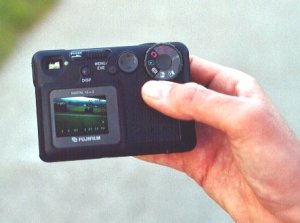Aerial Photography with Model Airplanes
Content:
- Background
- Mounting the cam
- Taking the first pictures
- Pictures
Background
Inspired by Tom Crowlys great aerial pictures and very good hints on how to take them, I started looking for a digital camera to suit my needs. I did not want to build a bigger wing and change the construction of my fuselage like Tom did, so I was searching for a slender and lightweight cam. In those times, the Fuji DX-10 proved to be exactly what I needed with an acceptable price.
Maybe one word about the used airplane. I think it's clear to everybody not to use a high speed aerobatic model for aerial photography. For sharp images, it is necessary to shut down the engine, since it causes to many vibrations. This means the model is gliding while the pictures are taken, so the gliding behaviour should be good. In my case the Lazy Bee was the perfect model for this task. More information about this great plane can be found on the International Lazy Bee Homepage, created together with Andreas.
My Bee is electrically driven, another big advantage for this task. In my eyes, the biggest advantage is that everything stays clean. No oil and other agressive fluids from which the camera has to be saved. On the other hand, the engine can be shut of and started at any time which makes taking the pictures a lot easier.
In the meantime I've built a larger wing which allows for a slower descent when the engine is turned of. It's more relaxing.
Mounting the cam
|
In order to trigger the cam, I mounted a servo by a carbon reinforced balsa bracket right onto the camera. Thus the lever of the servo pushes right onto the trigger button. It sounds astonishing, but the force needed to push it seems pretty big. The bracket however is elastic and enables the servo to bend away. I guess it's okay, since it spares the servo gear.
|

The Fuji DX-10 with the mounted servo.
|
Cushioned with foam, the cam fits perfectly secured into the Lazy Bee hull. I thought of using a kind of safety-belt in addition (just in case...), but until now everything worked great.
The cam "looks out" the starbord door (normaly used for changing the batteries), which is left open during flight. One little problem I discovered when everything was mounted was the necessity of switching the camera on after she was installed... :o) With this construction you need some very thin fingers to do so. Luckily I have them. :o)
|

The cam mounted in the fuselage.
|
Taking the first pictures
Before getting my cam airborne I did some testflying with a dummyweight. Just as expected, my Bee had to fly faster then usual, but she was able to take off by herself and was well controlable as usual.
This once again shows, what a great plane the Bee is. She can carry 1/3 of her takeoff-weight as payload. Even the C5 Galaxy can not carry more!
|
I tested the "Reconnaissance-Bee" for the first time during my flying-hollidays together with Andreas and I can tell you, I am hooked to this kind of photography. The first pictures were taken on an evening and were somewhat disappointing. It was just to dark
to take pictures, so most of them were far away from beeing sharp.
When taking pictures, it makes a great 3D-effect, when another airplane flies in your viewing angle. However, it's very difficult to pin point. As can be seen below, we sometimes did succeed to get Andreas models fly into the picture.
|

|
Pictures
First pictures taken near Feldkirchen-Westerham/Germany:

First sharp picture ever!
|

View on Feldkirchen.
|

|

Andreas & me under the tree.
|

Andreas' Bee!
|

Low pass.
|

Andreas' Bee.
|

The "junction airport".
|

Railway tracks make nice motives.
|

|

Ready to attack the tractor.
|

Patterns after mowing.
|
|
|
|
Pictures of a quarry pond near Feldkirchen/Germany.
Pictures of the field of the Bloemendalse Modelvlieg Club (BMVC) near Vijfhuizen/Netherlands. The fog severely troubled the view but hey, I wanted to see how it all looked from above.

|

|

Club house, our car & us.
|
|
|
Pictures of the beach near Katwijk/Netherlands. Due to the turbulences caused by the eastern wind and the dunes, the Bee was barely able to gain altitude.
Flying near Regensburg/Germany. The first two pictures where taken close to a highway and the rest on a shallow slope. Andreas did some slope soaring with his Sanstude and sometimes I managed to catch her.

Us and car.
|

The highway.
|

Slope and car.
|

Slope, car and Sanstude.
|

Sanstude in flight.
|

Sanstude again.
|

Matching speeds was a challenge.
|

|
|
|
|































